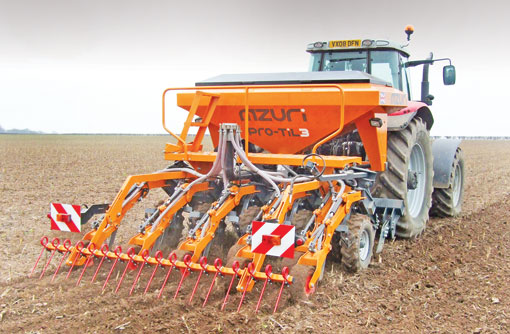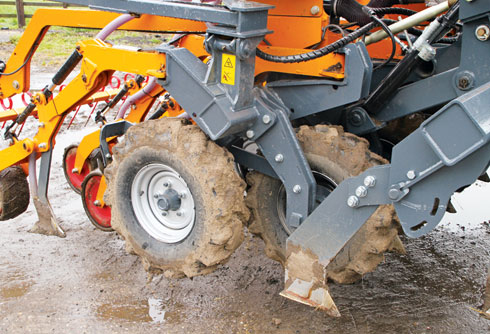Warwickshire farmer looks to a strip tillage future

You can see the appeal of strip tillage drilling. It’s a neat half-way house between true direct drilling (where the soil is not moved at all) and cultivation drilling (where all the soil is moved).
It certainly appealed to Rupert Inkpen, at Knowle near Solihull. He was looking for an establishment system which didn’t involve operating large, heavy cultivators requiring gallons of fuel and expensive, powerful tractors to pull them – and strip tillage seemed to offer a solution.
Mr Inkpen farms a total of 730ha (1,800 acres). Apart from about 20ha of forage maize, the land is all down to combinable crops – 360ha of winter wheat, 240ha of oilseed rape with the remainder in linseed and winter oats.
“Bearing in mind the land is spread over a number of farms located in quite a large area, the soil type tends to be very variable and ranges from red clay to light loams – and beyond,” he explains.
For the past decade, the cultivation regime has been non-inversion using a Vaderstad drill alongside a McConnel Shakearator and disc harrows to start with and then, in an effort to cut costs, a 6m Weaving cultivator drill with soil prepared by a Simba Solo.
The formation of a separate company with a neighbouring farmer to share the cost of larger implements helped to reduce the investment in machinery, but there was still a gnawing doubt as to whether this was the correct route to take.
Enter the Mzuri Pro-Til strip tillage drill, which was launched in a fanfare of publicity last year.
“We first tried a trailed version in September last year, which we used to plant oilseed rape into winter wheat stubble and then, in October, a 3m tractor-mounted version to drill winter wheat into linseed and forage maize stubble,” he explains. “We also used the mounted drill to plant winter wheat into sprayed off ryegrass.”
How does it work?
The key to the Mzuri system (Stand L1310), as with all strip tillage drills, is to only cultivate soil into which the seed is to be placed and to leave the space between rows totally unmoved.
This is achieved by a set of rigid tines complete with small wings, which, running in line with the seed coulters, can be set to work at depths as low as 30cm or more.
Angled to the rear, the tines are designed not to bring soil and clods up to the surface but just to loosen the soil in the root zone.
The soil is then pressed with pneumatic tyres with chevron lugs and a tine coulter places the seed in a band about 10cm wide.
Compared with a conventional drill, which will have a coulter spacing in the 120mm range, the 3m Mzuri has bands that have row spacing of 333mm (the 4m is 363mm) so the seed is more concentrated in the rows as a result.
“This is quite noticeable,” he says. “Particularly as we’ve been making same-field comparison trials with a conventional drill that has had soil prepared using min-till techniques.”
In operation, the drill is pulled by a 165hp New Holland T6090 tractor at speeds of up to 10kph and Mr Inkpen has opted not to put any tramlines into the crop, preferring to use GPS guidance for the first pass with the sprayer.

Tines are designed to not bring soil and clods up to the surface.
Results so far
So what have been the results so far? Bearing in mind that none of the crops sown by Mr Inkpen has been harvested, yield comparisons will have to wait a while.
But there’s no denying the crops look well, full of vigour and it would seem that both the oilseed rape and the winter wheat have taken full advantage of the wider rows.
“This could be the system we are looking for,” he says, albeit reservedly. “It’s not true direct drilling but it’s direct drilling with a degree of cultivation and root loosening,” he says.
There is clearly a lot to come to terms with if the strip tillage system is to be adopted for all time, but Mr Inkpen says he is quietly confident that it could be the start of a major change in the way he farms.
